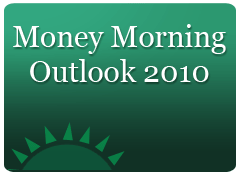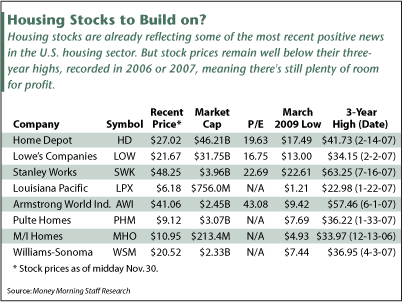[Editor's Note:This report on the U.S. housing market is the latest installment in Money Morning's "Outlook 2010" series, which chronicles global-investing opportunities for the New Year.]

If you were interested in homes for anything other than personal shelter, November was a pretty discouraging month, with continuing gloom the most prominent feature of virtually every report issued on the housing sector.
Whether it was the disappointing quarterly earnings numbers for America's top two home-improvement companies, the dismal listing of October housing starts and new building permits or the downbeat readings for the National Association of Home Builders (NAHB) Sentiment Index, you had to dig pretty deep to find any hint of a near-term rebound in the housing sector.
As investors, we all know that the U.S. housing market will eventually rebound. Consumer interest in housing will be fueled by improving business conditions, renewed jobs growth, a loosening of credit restraints for mortgages and the demands of a growing population for new and better places to live.
The two big questions are: When will that rebound begin - and what's the best way to profit from it?
Reading between the lines of the public and private-sector reports we've seen over the past two weeks, we can reach the following key conclusions:
- Although a full-blown housing recovery isn't in the cards right now, the sector is at least showing signs that it's bumping off the bottom.
- In fact, given the stock market's well-known role as a leading indicator for several sectors, the stock-price advances that we've seen since share prices bottomed in March confirm that a rebound has definitely begun.
Indeed, four specific developments offer a concrete confirmation of our analysis - and point at the investments we should be looking at as the best possible profit plays for the eventual housing-market turnaround.
Let's take a look:
- Rebounds by the Retailing Giants: Home-improvement leaders Lowe's Companies, Inc. (NYSE: LOW) and The Home Depot Inc. (NYSE: HD) reported third-quarter declines in earnings of 30% and 8.9% on Nov. 16 and 17, respectively, but Home Depot's results were well above analyst expectations and Lowe's executives said the firm's fourth-quarter revenue would exceed prior estimates. Both of the "Big Box" home-improvement retailers also said they were seeing "signs of improvement" in the country's hardest-hit housing markets. The reports prompted senior Piper Jaffray Cos. (NYSE: PJC) retail analyst Mitchell Kaiser to project that "both Lowe's and Home Depot will hit positive same-store sales [comparisons] in the second or third quarter of next year." Both stocks suffered losses of 2% to 3% on the earnings reports, but both finished the month well off their post-report lows, despite a couple of hits taken by the Standard & Poor's 500 Index, including its Dubai-inspired 1.7% decline in the shortened Black Friday session.
- A Look Behind the Numbers: While the NAHB's Sentiment Index slipped from 18 in October to 17 in November, the organization said the November reading was actually flat because October had been revised down to 17. The NAHB also noted that the survey was taken before the Obama administration's first-time homebuyer credit was extended, indicating the November Index might have actually risen had that $8,000 credit been factored in.
- "Hidden" Good News: The U.S. Commerce Department reported that new housing starts fell by 10.6% in October to a seasonally adjusted annual rate of 529,000, the lowest level since April. Building permits for new residential housing also fell 4.0% from September, reaching an annual rate of 552,000. That's down a whopping 30.7% from October 2008 - although the number was in line with expectations. Almost lost was the positive news that housing completions rose 1.9% from September (10.7% for single-family units) - an important development since developers in such hard-hit areas as Southern California, Phoenix and Las Vegas literally stopped projects in mid-framing when the bottom dropped out of the new-home markets. The National Association of Realtors (NAR) also reported that sales of existing homes in October far exceeded expectations, climbing by 10.1% (on top of a 9.4% gain in September) to a seasonally adjusted annual rate of 6.1 million. That pace, attributed largely to the homebuyer credit, was up 24% from the year-ago level.
- Regional Markets Recover: The latest Adversity Index, released at mid-month by Moody's Economy.com and MSNBC.com both reported that 100 U.S. metropolitan areas - almost one in four - had entered the early stages of economic recovery in September, up from just 79 metro areas in August. That was deemed encouraging for the overall national economy - and, by extension, the regional housing markets - although the report was careful to note that "the rebound continues to elude the big population centers," which are the true drivers of recovery.
If we take a look at the companies most closely associated with the U.S. housing market, we can see that their share prices are starting to benefit from the "good news" we've outlined here. And yet, even though the stocks in question have surged from their lows in early March, they remain well below their three-year highs set during the rampant bull market of 2006-07 - suggesting that there's still a major profit opportunity at hand here [Editor's Note: For more specific details, check out the stock-price chart that follows just below.]

If you're ready to boost your portfolio's exposure to the U.S. housing market, your shopping list should probably include:
The Home Depot Inc. (NYSE: HD) $27.02: As the world's No. 1 home-improvement store, Home Depot may well have the most to gain from rising sales of existing homes; after all, anybody who moves into a new home wants to make at least some changes. And they can get what they need from Home Depot. For those who can't afford a new home and have to fix up the old one, Home Depot is also the logical first (and perhaps only) stop. In addition to homeowners, the Atlanta-based company's 2,000-plus U.S. retail locations also cater to construction companies, tradespeople and building-maintenance professionals - not to mention the contractors operating in the "do-it-for-me" (DIFM) market. HD also deals in all major home appliances and tools. (As No. 2 player in the market, the same reasoning applies to Lowe's, which stood at $21.67 Monday, but the numbers are smaller.)
The Stanley Works (NYSE: SWK) $48.25: Whether you're planning to build it new, improve it or repair it, you have to have the right tool for the job, as do the contractors you opt to hire if you're not the "handy" type. And Stanley is one of the world's largest manufacturers and distributors of hand tools and power tools, as well as construction hardware. Stanley is also looking to cut into the competition and grab one of the other premier brand names in the business, having recently put in a bid to buy The Black & Decker Corp. (NYSE: BDK). SWK also provides security systems and has worldwide distribution - as does Black & Decker - positioning the company for intermediate and long-term growth, even if the U.S. economy lags in the global recovery.
Louisiana-Pacific Corp. (NYSE: LPX) $6.18: It takes lumber to build houses and Louisiana-Pacific is one of the country's leading lumber suppliers. It also manufactures and distributes building products for new home construction, for repair and remodeling, for manufactured housing, and for light industrial and commercial construction. The Nashville-based company wholesales products to retail home centers, manufactured-housing producers, distributors, other wholesalers and building materials dealers in North and South America, Asia and Europe. LPX has operated at a loss the past two years, but should quickly return to profitability as new housing starts again begin to rise.
Armstrong World Industries Inc. (NYSE: AWI) $41.06: Houses need floors and ceilings, and Armstrong World provides both. Nearing its 120th anniversary, the Lancaster, Pa.-based firm designs, manufactures and sells all types of flooring products, ceiling systems and cabinetry to markets in North and South America, Europe and around the Pacific Rim.
Pulte Homes Inc. (NYSE: PHM) $9.12, and M/I Homes Inc. (NYSE: (MHO) $10.95: When people start buying new houses, someone has to build them, and these two companies are among the leaders. Pulte is based in Michigan but has developments and home-sales offices in more than 450 U.S. communities. It also has a financing arm to help potential buyers. If you want a more regional choice away from the hard-hit West and Southwest, M/I builds single-family homes, attached townhouses and condominiums in developments that reach from Chicago to the Mid-Atlantic East-Coast region, and as far south as the Carolinas. MHO also has an insurance-brokerage arm specializing in real estate coverage.
Williams-Sonoma Inc. (NYSE: WSM) $20.52: Whether you're happy with your current digs, are moving to an existing house, or are building a new one, you want the interior to feel like home - and Williams-Sonoma can make that happen. The company has more than 600 retail stores that sell culinary and serving equipment, cookware, cookbooks, cutlery, dinnerware, glassware, table linens, and specialty foods and cooking ingredients. It also sells home furnishings, decorator items, bed-and-bath products, bridal and gift items under the West Elm and Pottery Barn brands.
[Editor's Note: Money Morning's "Outlook 2010" series has already provided readers with a forecast for the U.S. economy in the New Year. Watch for future installments addressing the economic outlook for oil prices, the high-tech sector, retailing, energy, commodities and other key areas investors need to be familiar with. For past installments in this series, please click here.]
News and Related Story Links:
- Money Morning "Outlook 2010" Economic Forecasting Series:
Series Archive - Wikinvest:
Home Depot - CNNMoney.com:
Baby Boomers: Do-it-for-Me Generation - Money Morning Investment News Briefs:
Stanley Works Nails Black & Decker Deal.


